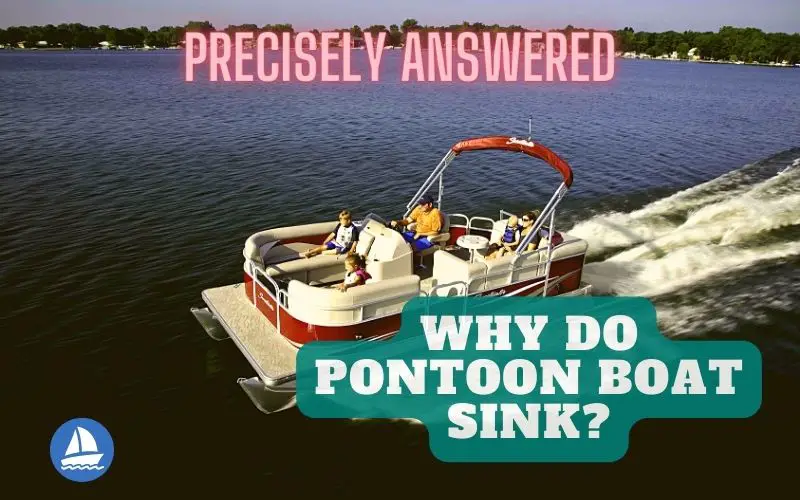Why Do Pontoon Boat Sink? Pontoon boats are lightweight leisure vessels typically used for fishing, water sports, and partying.
They feature a deck mounted onto two to three sealed aluminum tubes that are designed to float with ease. They’re very stable and safe when used correctly and under the right conditions.
Pontoon boats can sink for a variety of reasons, including:
- Overloading: One of the most common reasons for pontoon boat sinking is overloading. Pontoon boats have a maximum weight capacity, and exceeding that capacity can cause the boat to become unstable and capsize.
- Hull damage: Hull damage is another common cause of pontoon boat sinking. If the hull is damaged, it can allow water to enter the boat, causing it to sink.
- Improper maintenance: If a pontoon boat is not properly maintained, it can develop leaks or other issues that can cause it to sink. For example, if the bilge pump or other drainage systems are not functioning correctly, water can accumulate in the boat and eventually cause it to sink.
- Bad weather conditions: Extreme weather conditions such as storms, high winds, or waves can cause a pontoon boat to sink, particularly if the boat is not properly secured or anchored.
- Operator error: Operator error can also lead to the pontoon boat sinking. For example, if the boat is not operated properly, such as driving at high speeds in rough waters or making sudden turns, it can become unstable and capsize.
Overall, proper maintenance, adherence to weight limits, and safe boating practices can help prevent pontoon boats from sinking. It’s also important to keep a close eye on weather conditions and avoid operating the boat in dangerous conditions.
Why Pontoon Boats are Difficult to Sink?
Pontoon boats are designed to be difficult to sink due to their unique construction and design. Unlike traditional boats that have a single hull, pontoon boats have two or three pontoons (or tubes) that are filled with air and provide buoyancy.
Here are a few reasons why pontoon boats are difficult to sink:
- Multiple pontoons: As mentioned, pontoon boats have two or three pontoons that provide buoyancy. Even if one pontoon is damaged or punctured, the remaining pontoons can still provide enough buoyancy to keep the boat afloat.
- A large volume of air: The pontoons of a pontoon boat contain a large volume of air, which is much less dense than water. This provides a significant amount of buoyancy, even if the boat takes on water.
- Built-in flotation: Many pontoon boats have built-in flotation foam that is installed between the pontoons or under the deck. This foam provides additional buoyancy and helps the boat stay afloat even if the pontoons are damaged.
- High freeboard: Pontoon boats typically have a high freeboard, which is the distance from the waterline to the top of the boat’s side. This design feature helps to keep water from splashing over the sides of the boat and flooding the deck.
- Self-bailing deck: Many pontoon boats have a self-bailing deck, which means that any water that comes on board will drain out through scuppers or other drains. This can help prevent the boat from becoming swamped.
While pontoon boats are generally difficult to sink, it’s still important to operate them safely and take necessary precautions to prevent accidents. Always wear a life jacket, follow boating safety guidelines, and use caution when operating your pontoon boat.
But Do Pontoon Boats Capsize?
While a pontoon boat can capsize, it is less likely to happen than with other types of boats. This is because of the design and construction of pontoon boats, which makes them more stable in the water than many other types of boats.
Pontoon boats are designed to be more stable by having a wide, flat deck and two or three pontoons that provide buoyancy and stability. The pontoons are filled with air and are located on either side of the boat, providing a wide base of support that helps to keep the boat from tipping over.
However, there are situations where a pontoon boat could capsize, such as if it encounters very rough water, high winds, or if the boat is overloaded with too much weight. If a pontoon boat were to capsize, it could be difficult to right the boat due to its size and weight.
It’s important to note that even though pontoon boats are less likely to capsize than other types of boats, it’s still important to practice safe boating techniques and follow all boating safety guidelines.
This includes wearing life jackets, staying within safe weight limits, and being aware of weather and water conditions before setting out.
Can a Pontoon Boat Sink?
While it is less likely for a pontoon boat to sink than other types of boats due to their buoyancy and multiple pontoons, it is still possible for a pontoon boat to sink under certain circumstances. For example:
- Damage to the pontoons: If the pontoons of a pontoon boat are punctured or damaged, they can lose their buoyancy and the boat can begin to take on water.
- Overloading: If a pontoon boat is overloaded with too much weight, it can become unstable and take on water, which could lead to sinking.
- Flooding: If water can get into the boat and cannot be drained out, it could cause the boat to sink. For example, if the boat is left out in heavy rain or if the boat is swamped by large waves or wakes, it could take on water and eventually sink.
- Capsizing: While it is less likely for a pontoon boat to capsize than other types of boats, it is still possible under certain conditions. If a pontoon boat were to capsize, it could be difficult to right the boat due to its size and weight, which could potentially lead to sinking.
It’s important to follow all boating safety guidelines and to regularly maintain your pontoon boat to prevent damage or malfunctions that could lead to sinking.
If you notice any signs of damage to your boat, such as punctures, cracks, or leaks, it’s important to have them repaired as soon as possible to prevent further damage and ensure the safety of everyone on board.
How Hard is it to Sink a Pontoon?
If you’re looking to buy a new pontoon boat, you might have some questions about its safety. After all, you’ve heard from friends that these boats are extremely durable and “unsinkable.”
While a pontoon can’t sink completely, it can fill with water and become submerged. However, this is a rare occurrence and one that can be avoided with careful planning.
When it comes to securing your gear, you should always make sure that it’s tightly bundled and placed as low as possible in the boat. This will ensure that it won’t shift during navigation and cause your pontoon to take on water.
You should also avoid overloading your pontoon with too much weight. This can lead to the boat taking on too much water and sinking quickly.
It’s best to stick with shallow waters when you’re out on a pontoon, so don’t go out in the ocean or deep waters. These aren’t the types of areas that your boat was designed for and can lead to serious injury or even death.
Choosing the Right Boat
If you want to be safe on your pontoon, you should choose a model that’s well-built and durable. Look for a pontoon that’s made of heavy gauge aluminum and has internal reinforcement in the nose cones to help them stand up to rough weather conditions.
Wave tamers and lifting strakes are also great features to look for. These will help your pontoon handle big chop and keep it from plowing into the water.
What Do You Do if Your Boat Sinks Into The Ocean?
If your boat sinks in the ocean, it can be a frightening experience. However, there are steps you can take to increase your chances of survival. Here are some important things to keep in mind:
- Stay Calm: Try to stay calm and avoid panicking. Panic can make it difficult to think clearly and take appropriate action.
- Call for Help: If possible, try to call for help using a marine radio, cell phone, or another communication device. Let the Coast Guard or other rescue organizations know your location, the number of people on board, and any other relevant information about your situation.
- Put on Life Jackets: Put on life jackets or other floatation devices to help keep you and other passengers afloat.
- Stay with the Boat: If possible, stay with the boat as it may provide some shelter and protection. The boat can also serve as a beacon for search and rescue teams.
- Signal for Help: Use flares, mirrors, or other signaling devices to help rescuers locate you.
- Stay Warm: If you’re in the water, try to stay as warm as possible by huddling together with other passengers and avoiding exposure to wind and waves.
- Stay Hydrated: If you have access to fresh water, drink it to stay hydrated. If not, try to conserve your energy and avoid overexertion to prevent dehydration.
Remember, every situation is different, and the actions you take will depend on the circumstances of the sinking. The most important thing is to try to stay calm, assess the situation, and take appropriate action to increase your chances of survival until help arrives.

